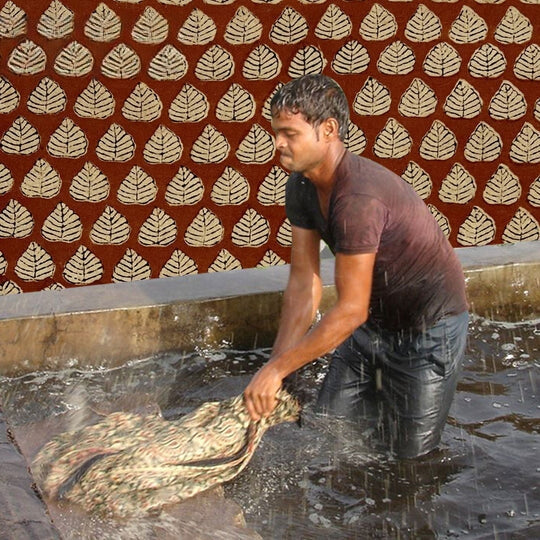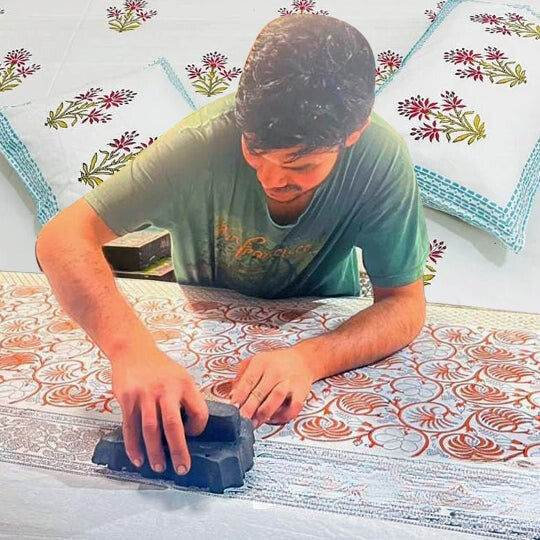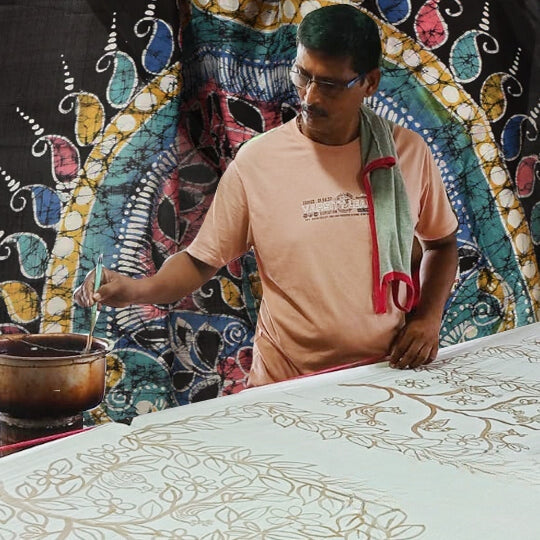Being in existence for more than 5,000 years, a saree was a humble drape used by women in India. Still ever present on ramps at leading fashion shows, on streets of rural and urban India, on college students and their conservative grandmothers, the saree is as entrenched in our culture as it ever was.
This festive season, we turn the spotlight on to nine weaving traditions from across the country: the Sambalpuri, Maheshwari, Pochampally, Kanchi, Banarasi, Bomkai, Jamdani, Chanderi and the Venkatagiri.
Sambalpuri Saree


Sambalpuri ikat migrated to Western Odisha with the Bhulia community who are believed to have fled Northern India after the fall of the Chouhan Empire in the year 1192 AD. The Bhuliya community of Meher tribe have been practicing this craft for generations and have levelled up in terms of innovation as the years went by. The Sambalpuri saree reflects an ancient handicraft called Baandha Kala. The threads are first tie-dyed and later woven into a fabric, with the entire process taking many weeks. This versatile technique enables a craftsman to weave traditional motifs like shankha (shell), chakra (wheel), phula (flower) as well as modern motifs like deer, lion and elephant with precision. One of the unique features of Sambalpuri ikat is the design is reflected almost identically on both sides of the fabric. The different weaving procedure gives the saree a slightly rough texture. The sarees are usually woven in cotton & silk and come in black, red, yellow and green colours representing the Odisha culture.
Link to Sambalpuri Collection
Maheshwari Saree

A prime centre for handloom weaving since the 5th Century, Maheshwar an ancient town on the banks of Narmada enjoyed a considerably elevated status in terms of royal interests. Rani Ahilya Bai Holkar who designed and wove the first Maheshwari saree employed craftsmen from Surat and Malwa to produce these sarees. Popular motifs like chattai pattern, Chameli ka phool the eent are some of the motifs used, all of which may be traced back to the detailing on the walls of Maheshwar Fort.
Through its evolution, the eent (brick) pattern and the heera (diamond) patterns still have a strong presence in these sarees.
Originally, the Maheshwari saree was made of pure silk and dark shades like maroon, black, purple and green. In course of time, these sarees were made in lighter shades and in pure cotton as well as a mixture of silk and cotton.
Link to Maheshwari Collection
Pochampally saree


Bhoodan Pochampally marked its rightful place in Indian history as a silk mine in the 18th century. The widely applauded Ikat saree was brought to the small town of Pochampally from Chirala where the art was locally referred to as chit-ku. Pochampally sarees are made using the warp single ikat technique. It is a process where warp goes through the resist dyeing procedure. After which, they are woven into a single cloth. This is a very challenging and intricate process occasionally taking up to 100 days to make a single saree. Traditionally only geometric patterns and motifs were woven on sarees. Keeping up with today's trend various modern intricate motifs like flowers, leaves, circles, paisleys and more are making their way into these beautiful weaves. These intricate details give a mesmerising touch to the Pochampally sarees, as the Ikats are smooth and sharp.
Link to Pochampally Collection
Kanchi saree

The story of Kanchipuram silk saree begins in Hindu Mythology. Kanchi weavers are descendants of Sage Marakanda, who was considered to be the master weaver for the gods themselves. The early weavers migrated from Andhra Pradesh to the town of Kanchipuram and translated images of the sculptures and figurines found on the temples into motifs woven on the saree. Temple borders, checks, stripes and floral (buttas) are some of the traditional designs found on Kanchipuram silks.
In a traditional mulberry silk saree, the body and border are woven separately and then interlocked together. The joint is woven so strongly that even if the sarees tears, the border will not detach. If the pallu has to be woven in a different shade, it is separately woven and then delicately joined to the saree often denoted by a zig zag line. Kanchipuram sarees woven with heavy silk and gold cloth are considered to be special and are worn on occasions and festivities.
Link to Kanchi Collection
Banarasi


Banarasi silk has its roots seeped into the rich cultural history of India. Originally crafted exclusively for the royalty, each Banarasi saree was created from real gold and silver threads, taking as much as a year to make. Banarasi silk is an unmatched example of excellent artistry brought to India by the Mughals. The sarees are decorated with intricate floral as well as foliate designs inspired from the Mughals. Normally 3 weavers work on one Banarasi saree, One weaves the saree, the second one handles the revolving ring in making bundles, and the third one assists in border designing. Some of the special features of Banarasi silk sarees are the heavy working of gold, small detailed figures, metal visual effects and compact weaving. They are one of the finest traditional sarees in India and very heavy due to its rich weave work which makes them ideal for parties, festivals, and weddings.
Link to Banarasi Collection
Bomkai

Bomkai Sarees were produced only for the provincial royalty of Odisha and for the esteemed upper class and Brahmins of the region in 14th century. The charm of the saree is the use of fish as a motif which is believed to be a sign of success and affluence and charming thread work on the Pallu and border. These sarees are simple with a tribal tinge and yet very elegant usually in red, black and white background. Today you will find the saree in several designs and multiple colours while retaining the originality. Bomkai cotton sarees are usually an everyday wear and the silk sarees are worn for ceremonies and sacred occasions. The sketches of some of the complex weaving patterns used in making a Bomkai saree can be found inside the Khandagiri caves of Odisha even today.
Link to Bomkai Collection
Jamdani


Around the 12th century, Islamic influences infused cotton fabric with countless motifs and colours. It was during Akbar's reign that the art blossomed into its most exquisite form—the flowered muslin, Jamdani. Jamdani is a discontinuous weft technique of weaving. The motifs are inlaid into the fabric by adding a denser thread to the warp threads by hand. This process is considered the most time intensive and one of the most advanced hand weaving techniques. Initially the motifs were nature inspired but geometric in shape as the weavers created these motifs by counting threads. Jamdani is an enduring craft; its specialism lies in the ability to integrate new techniques. From contrasting monotones of white-on-white, its palette has expanded into colourful, vibrant forms. While Jamdani began as cotton muslin, its weaves have incorporated threads of silk, silver, gold over time.
Link to Jamdani Collection
Chanderi

Chanderi silk saree has references dating back to the ancient Sanskrit literature Rig Veda and The Mahabharata. The love for this fabric was greatly intensified in the Mughal era when the queens were often seen flaunting Chanderi silks in courts and on special occasions. Chanderi, a small town in Madhya Pradesh, is among the most popular handloom locations in India dating back to the 11th century. The traditional Indian fabric of Chanderi is known for its sheer texture, its light weight and luxurious drape. The motifs seen on Chanderi silk are hand woven using separate needles for creating motifs on handloom. Weavers coat these motifs with gold, silver as well as copper to add a festive touch. Motifs used in chanderi weaving are inspired from nature and include Swans, gold coins, fruits, and heavenly bodies. Color palette of Chanderi sarees are predominately ruled by soft pastel, however with changing times, vibrant combinations of turquoise and navy blue, fuchsia and white also exist.
Link to Chanderi Collection
Venkatagiri

The Venkatagiri Sarees, known for their fine weaving, dates back to early 1700 where it was patronized by the Velugoti Dynasty of Nellore and was produced at an artisan cluster close to Nellore. These sarees were woven only for the royal families back in the day making them very exclusive. The distinctive feature of a Venkatagiri saree is a big Jamdani motif of a peacock, parrot, swan, mango or leaf woven in the pallu. The fine weaving and unique zari designs made this the preferred choice of royalty in Andhra Pradesh. Initially they were made using Cotton thread. Over time, silk threads made their way into these unique sarees. Coming from the historic town of Venkatagiri in the state of Andhra Pradesh, these are one of the softest and most durable south sarees in India.
Link to Venkatagiri Collection






Leave a comment